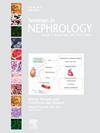阿根廷第一民族的心血管和肾脏危险因素:库姆和威奇土著群体的研究。
IF 3.5
3区 医学
Q2 UROLOGY & NEPHROLOGY
引用次数: 0
摘要
2017年全球政策制定的“全球肾脏健康10项建议”是对所有利益攸关方的承诺和挑战。在诸如第一民族(FNP)这样的弱势群体中实现这些目标更具挑战性。库姆族和威奇族是与世隔绝的阿根廷民族自由主义者,很难获得保健服务。2003年,阿根廷查科省Qom FNP对慢性肾脏疾病(CKD)的研究表明,385人的蛋白尿率很高,但肾小球滤过率没有下降。2018年,随后对仍生活在该地区的人进行的横断面评估显示,糖尿病(DM)增加了6倍(从2%增加到14%),肥胖增加了3倍(从21%增加到61%)。感染(肺结核)和心血管疾病是整个样本中死亡的主要原因,而妇科癌症是妇女和男性心血管疾病的第一死因。2018年,一组新的受试者(不是2003年最初评估的受试者)显示,尽管他们与2003年最初评估的受试者一样年轻,但肾脏风险因素的患病率与15年后评估的受试者一样高。在2020年,Wichi FNP显示出较低的蛋白尿率(14%),几乎没有DM的存在。FNP应该建立CKD检测和治疗的公共政策,但它们必须基于当地的科学证据,持续监测和学习以及可扩展的策略。本文章由计算机程序翻译,如有差异,请以英文原文为准。
Cardiovascular and Renal Risk Factors in the Argentine First Nations: A Study of the Qom and Wichi Indigenous Groups
The “10 Recommendations for Global Kidney Health” developed at the Global Policy 2017 constitute a commitment by and challenge to all stakeholders. Achieving these goals in disadvantaged population such as the First Nation Peoples (FNP) is even more challenging. Qom and Wichi ethnics are isolated Argentine FNP with poor access to health care. Research on chronic kidney disease (CKD) in Qom FNP in the Chaco Province, Argentina showed high rates of proteinuria without a decrease of the glomerular filtration rate in a group of 385 persons in 2003. In 2018, a subsequent cross-sectional evaluation in those individuals still living in the area revealed that diabetes mellitus (DM) increased sixfold (from 2% to 14%) and obesity increased threefold (from 21% to 61%). Infections (tuberculosis) and cardiovascular disease were the main causes of mortality in the whole sample, whereas gynecologic cancer was the first cause of death in women and cardiovascular disease in men. In 2018, a new group of subjects (not those originally assessed in 2003) showed a remarkably high prevalence of renal risk factors despite being as young as those originally evaluated in 2003 but with a prevalence of renal risk factors as high as when the latter were assessed 15 years afterward. Wichi FNP, in 2020, showed lower proteinuria rates (14%) with virtually no presence of DM. FNP deserve the creation of public policies for CKD detection and treatment, but they must be based on local scientific evidence, with continuous monitoring and learning and scalable strategies.
求助全文
通过发布文献求助,成功后即可免费获取论文全文。
去求助
来源期刊

Seminars in nephrology
医学-泌尿学与肾脏学
CiteScore
5.60
自引率
0.00%
发文量
27
审稿时长
6-12 weeks
期刊介绍:
Seminars in Nephrology is a timely source for the publication of new concepts and research findings relevant to the clinical practice of nephrology. Each issue is an organized compendium of practical information that serves as a lasting reference for nephrologists, internists and physicians in training.
 求助内容:
求助内容: 应助结果提醒方式:
应助结果提醒方式:


